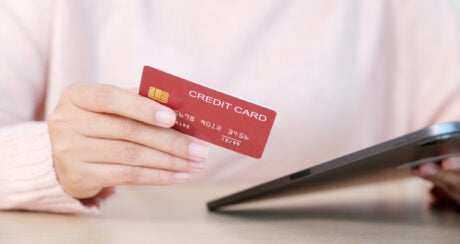If you misplace your credit card, don’t freak out. You don’t necessarily need to cancel it — instead, you can lock access to your card almost immediately by following a few simple steps.
What is a card lock?
A card lock is essentially an on-off switch that allows you to temporarily freeze or block credit cards and most debit cards.
Credit card companies call this feature different names, but most use ‘lock’ or ‘block’ to refer to the security practice.
The idea is that, if you’ve lost your card, you can lock it to have instant protection against fraudulent transactions. It’s the quickest way to safeguard your account and prevent anyone from using your card if it gets into the wrong hands.
Why lock a card?
You’re usually not liable for fraudulent credit card charges, but it’s still best to avoid the trouble that comes with credit card misuse. So, even if you may have left your card at a restaurant or can’t find it, locking it will buy you time to search and avoid cancelling and replacing a card hiding underneath something.
If you locate the card, you can unlock it, saving the hassle of cancelling your credit card and getting a replacement.
How locking a card works
Locking (and unlocking) your card gives you more security control. Most banks offer a toggle Lock/Unlock function in online banking. You can do this conveniently once logged in — just check the specific terms.
For example, ANZ automatically cancels your card if you report it lost or stolen, and you’ll receive a new card in 5 to 7 days. This process differs from putting a temporary block on your card, which won’t cancel it.
If you’re unsure where your card is and want to look for it, it’s best to put a lock on it and then report it missing. Before taking action, check how your bank treats card locks and cancellations.
What happens to transactions once a card is locked
All future transactions will be denied once you lock or freeze a card. You won’t be able to use the card online or in person. Locked cards still incur fees and interest, as standard functioning cards do, so you must meet your monthly minimum repayments even if the card isn’t active.
Check with your bank regarding recurring payments. If you’re with CommBank, for example, a card lock doesn’t apply to transactions flagged as recurring. For Westpac, any direct debits on a linked bank account will continue.
If you’ve temporarily blocked your credit card, the next step is to determine whether to close or unlock it. If there’s been a security breach (an unknown transaction or you suspect it’s stolen), cancel it. If you’re unsure where it is, keep it locked until you locate it or report it as lost.
» MORE: Does cancelling a credit card affect your credit rating?
How long does a temporary lock last?
How long your card is locked will depend on your bank. Westpac and St. George Bank temporarily locks cards for 15 days. Toggle ‘Unlock’ in Card Services if you find it before then. Other banks don’t specify a time on the lock.
As a general rule, card blocks are meant to be a temporary solution. Aim to decide whether to get a replacement or unlock it within a few days, as it’s best to avoid being cardless for too long.
Drawing out the process for weeks will only add to the inconvenience. For example, NAB customers can unblock a card through online banking for up to 42 days. After that, you have to call customer service to reactivate.
Locks often come with added safety protections for customers. For example, if a locked NAB card is used at an ATM, the machine will keep it and not return it to whoever attempted the withdrawal.
How to lock (and unlock) your credit card in seconds
Follow the simple guidelines outlined by your bank. Online banking is the easiest way to activate and deactivate the card block. You can do this from your phone, wherever you are.
- Log into the CommBank app and tap ‘Cards’
- Select the card you want to lock
- Select the lock, block or limit feature
- Tap ‘Lock temporarily’.
- Log into the NAB app and click ‘Cards’
- Tap the card you want to lock
- Turn the toggle on next to ‘Block card’
- Press confirm, and you’ll see a ‘this card has been temporarily blocked’ message.
- Tap ‘Cards’ in the menu
- Select the card
- Tap on ‘Lock card temporarily’.
- Log into the ANZ app
- Choose the account
- Tap ‘Manage’, then ‘Manage Card’
- Tap on ‘Report Card Lost or Stolen’ and follow the prompts.
Turning off the block is just as easy. Use the same prompts to unlock the card.
MORE: How to activate a new or replacement card
Using a card lock strategically
Locking a credit card can also be a temporary strategy to stop spending. If you’re trying to pay down your credit card but find yourself using it out of habit, consider locking it for a few weeks.
It might be worth speaking to your bank directly, so you can explain your situation and avoid getting a replacement card. Notify them so they know there hasn’t been a security issue. Set a reminder to make your minimum monthly repayments and keep your accounts in good shape.
While locking or replacing a credit card can be frustrating, keeping your money safe is a small inconvenience.
DIVE EVEN DEEPER

What To Know About CVV and CCV Numbers in Australia
CVV stands for ‘card verification value’ — it’s a three- or four-digit security code found on debit and credit cards that helps protect against fraud.

What Do Credit Card Numbers Mean?
Your credit card number may feel random, but it’s actually packed with information that helps authenticate transactions and protect against fraud.

What Is a PIN (Personal Identification Number)?
A personal identification number (PIN) is a four-digit security code on a credit or debit card that authenticates the user’s identity. Using a PIN is safe, fast, and convenient.

Understanding your credit card’s expiration date
A credit card expiration date shows when the card is no longer valid. There are things you should consider to avoid interruptions or fees when your credit card expires.

